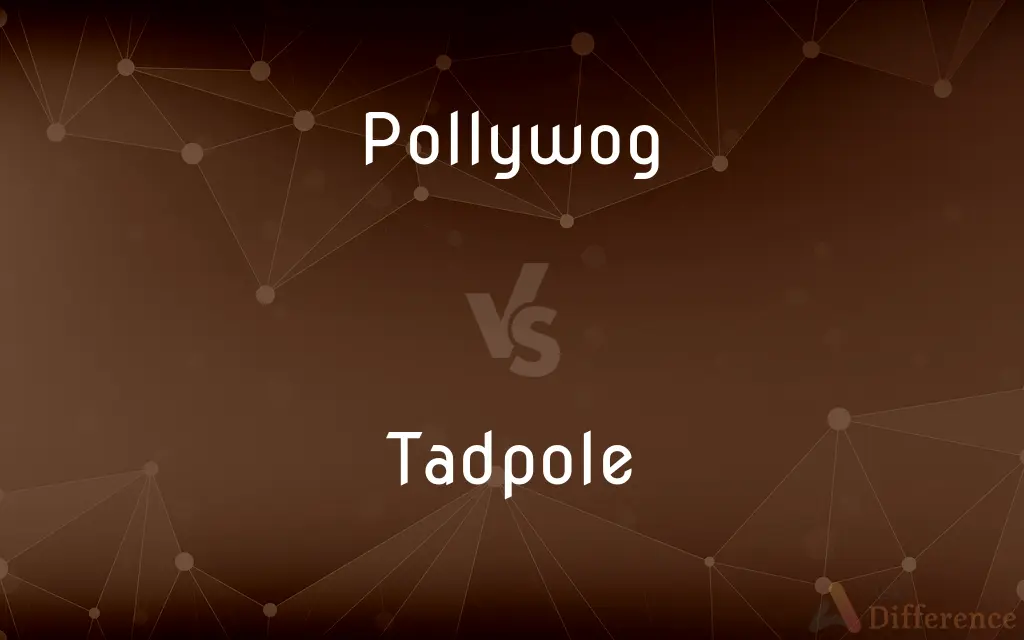Pollywog vs. Tadpole — What's the Difference?
By Tayyaba Rehman & Fiza Rafique — Updated on March 27, 2024
Pollywog and tadpole both refer to the larval stage of amphibians, but "tadpole" is more commonly used in scientific contexts.

Difference Between Pollywog and Tadpole
Table of Contents
ADVERTISEMENT
Key Differences
Pollywog is a term often used in informal contexts to describe the larval stage of an amphibian, notably a frog or toad, characterized by its distinctive tail and developing limbs. On the other hand, tadpole is the term more widely recognized and used in scientific literature to describe the same stage.
These larvae are aquatic, breathing through gills before they metamorphose into their adult form, where they develop lungs for breathing air. While "pollywog" evokes a more colloquial or regional use, "tadpole" is universally understood across various English-speaking regions, making it the preferred term in educational and professional settings.
Both terms describe creatures that undergo a significant transformation, changing from a fully aquatic form to an adult capable of living both in water and on land, but the journey of a tadpole is often documented more meticulously in studies of amphibian development.
Comparison Chart
Definition
Informal term for a young amphibian larva, especially frogs and toads.
Scientific term for the larval stage of amphibians, particularly frogs and toads.
Usage
More common in colloquial and regional English.
Preferred in scientific and academic contexts.
ADVERTISEMENT
Geographic Preference
Variably used, with some regions preferring "pollywog" over "tadpole."
Universally recognized and used across various English-speaking regions.
Context of Use
Used in everyday, informal conversations.
Used in educational, professional, and scientific discussions.
Association
Often associated with a more playful or less formal understanding of amphibian life stages.
Associated with scientific accuracy and biological study.
Compare with Definitions
Pollywog
A young amphibian, especially a frog or toad, in its larval stage featuring a tail and developing limbs.
The children were excited to find pollywogs in the pond during their nature walk.
Tadpole
Frequently used in textbooks and academic literature to explain amphibian development and metamorphosis.
The textbook chapter on amphibians provides detailed illustrations of the tadpole stage.
Pollywog
Sometimes used metaphorically to describe a person in the early stages of a process or development.
As a new intern, he felt like a pollywog in the vast ocean of the corporate world.
Tadpole
Used scientifically to describe the early developmental stage of amphibians, emphasizing its biological aspects.
The biologist noted the rapid growth rate of tadpoles in the controlled environment.
Pollywog
A term used primarily in informal or colloquial contexts to describe the early life stage of amphibians.
My grandfather used to tell stories of catching pollywogs in the creek behind his house.
Tadpole
Indicates an aquatic larva that breathes through gills before metamorphosing into a lung-breathing adult.
Tadpoles undergo a remarkable transformation, losing their tails and developing legs.
Pollywog
Refers to a creature in a transitional phase, highlighting the process of metamorphosis from water to land dwelling.
Watching a pollywog transform into a frog offers a fascinating glimpse into the process of metamorphosis.
Tadpole
The larval stage of an amphibian, particularly a frog or toad, characterized by a tail and eventual development of limbs.
Tadpoles can often be seen in ponds or slow-moving streams during the spring.
Pollywog
Often used in educational settings when introducing younger audiences to the concept of amphibian life cycles.
The science teacher used a pollywog to explain metamorphosis to the first-grade class.
Tadpole
Can denote the simplicity and starting point of life's complexity in metaphorical uses.
In his autobiography, he described his humble beginnings as a tadpole in the pond of life.
Pollywog
Variant of polliwog.
Tadpole
A tadpole is the larval stage in the life cycle of an amphibian. Most tadpoles are fully aquatic, though some species of amphibians have tadpoles that are terrestrial.
Pollywog
A person of Polynesian (usually Samoan) descent.
Tadpole
The aquatic larva of a frog or toad, having gills, a long, laterally compressed tail, and in early stages, no limbs. During metamorphosis of a tadpole into an adult, legs and lungs develop, and the tail gradually disappears. Also called polliwog.
Pollywog
A polliwig.
Tadpole
A young toad or frog in its larval stage of development that lives in water, has a tail and no legs, and, like a fish, breathes through gills.
Pollywog
A larval frog or toad
Tadpole
(by extension) The aquatic larva of any amphibian.
Salamander tadpole
Tadpole
A type of cargo bike that has two wheels in front and one in back.
Tadpole
(psychology) A child's basic drawing of a human being, having a detailed head but only sticks for the body and limbs.
Tadpole
(informal) A small child.
Tadpole
The young aquatic larva of any amphibian. In this stage it breathes by means of external or internal gills, is at first destitute of legs, and has a finlike tail. Called also polliwig, polliwog, porwiggle, or purwiggy.
Tadpole
The hooded merganser.
Tadpole
A larval frog or toad
Common Curiosities
Are pollywogs and tadpoles the same?
Yes, pollywogs and tadpoles refer to the same amphibian larval stage, though "tadpole" is the term more commonly used in scientific contexts.
How do pollywogs breathe?
Pollywogs breathe through gills, allowing them to live in water before they metamorphose and develop lungs for breathing air.
What is a tadpole?
A tadpole is the scientifically recognized term for the larval stage of amphibians, marked by a tail and the gradual growth of limbs.
What is a pollywog?
A pollywog is the larval stage of an amphibian, especially of frogs and toads, characterized by a tail and developing limbs.
Is "pollywog" a scientific term?
While "pollywog" accurately describes the larval stage of amphibians, it is considered more informal compared to the scientific term "tadpole."
How long does it take for a pollywog to become a frog?
The time it takes for a pollywog to metamorphose into a frog varies by species but generally ranges from a few months to up to three years.
What do tadpoles eat?
Tadpoles primarily eat algae and plant material, though some species may also consume animal matter or detritus.
Can you keep tadpoles as pets?
Tadpoles can be kept as pets with proper care, including maintaining clean water conditions and providing appropriate food, but their needs change as they develop.
Where can you find pollywogs or tadpoles?
Pollywogs and tadpoles are typically found in aquatic environments like ponds, streams, or wetlands.
Can pollywogs survive out of water?
Pollywogs are aquatic and must remain in water to survive as they breathe through gills; they cannot live out of water until they metamorphose.
Do all amphibians have a tadpole stage?
Most amphibians undergo a tadpole or similar larval stage, though the specifics of their development can vary widely among species.
Why are tadpoles important for the ecosystem?
Tadpoles play a crucial role in aquatic ecosystems by feeding on algae, thus contributing to the control of algae growth and maintaining water quality.
What animals do pollywogs grow into?
Pollywogs grow into adult amphibians, such as frogs and toads, undergoing significant physical changes during metamorphosis.
Are pollywogs dangerous?
Pollywogs are not dangerous; they are harmless larval amphibians undergoing their natural life cycle.
How do tadpoles breathe underwater?
Tadpoles breathe underwater through gills, which allow them to extract oxygen directly from the water.
Share Your Discovery
Previous Comparison
Dictionary vs. Lexicon
Next Comparison
Gateway vs. EntranceAuthor Spotlight
Written by
Tayyaba RehmanTayyaba Rehman is a distinguished writer, currently serving as a primary contributor to askdifference.com. As a researcher in semantics and etymology, Tayyaba's passion for the complexity of languages and their distinctions has found a perfect home on the platform. Tayyaba delves into the intricacies of language, distinguishing between commonly confused words and phrases, thereby providing clarity for readers worldwide.
Co-written by
Fiza RafiqueFiza Rafique is a skilled content writer at AskDifference.com, where she meticulously refines and enhances written pieces. Drawing from her vast editorial expertise, Fiza ensures clarity, accuracy, and precision in every article. Passionate about language, she continually seeks to elevate the quality of content for readers worldwide.














































